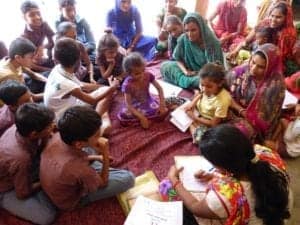On a hot afternoon in September, Savings Specialist Ryan Newton, Market Research Specialist Anjali Banthia, and I were in a SEWA Bank branch in Ahmedabad, India, conducting a focus group with a few young women who are daughters of SEWA Bank clients’ daughters. Ritu, a 16- year-old girl with her hair pulled into a short ponytail, is a Tejasvi account holder. The Tejasvi (“bright like a star” in Gujarati) Savings Program is a youth savings program that Women’s World Banking helped SEWA Bank to launch in March 2014. Our team was there to evaluate the results of a six-month pilot and we were eager to find out whether the insights from our initial research were borne out: that given the opportunity to save at a formal financial institution, youth have the capacity to save and can save a significant amount.

The results showed that more accounts were opened than initially projected and youth were able to save more than twice the projected amount. But the numbers also yielded something very interesting. Female youth have an equal capacity to and interest in saving, if not more, than male youth: 55 percent of accounts were opened by girls and girls were saving more on average than boys in both rural and urban areas.
But capacity is often foiled by reality. For instance, towards the end of the focus group, Ritu expressed her frustration about going to school because her parents prohibit her from going outside the home, “There is discrimination between girls and boys. Why is it that a boy can go anywhere? Just like [in] business, girls can’t do anything.”
Just because you want to doesn’t mean you can

Ritu’s comment highlights a stark reality for Indian girls, or perhaps female youth more generally: access to financial institutions may be a bigger gender barrier than saving itself. Gender discrimination in financial access not only illustrates itself in mobility but also in access to financial education. Not surprisingly, this is not only true in Ritu’s community but also in more developed countries. The 2015 Teens & Personal Finance Survey released by Junior Achievement USA® and The Allstate Foundation showed that even in the US, “teen girls are more likely than boys to say their parents don’t talk to them enough about money management (40 percent to 24 percent).[1]”
This reality in both the developed and developing world highlights how important it is for girls to have the right tools and experience to protect themselves against risks. A savings account with financial education can help a girl to build good savings behavior and prevent wasteful spending.
It also offers an opportunity to equip them with budgeting and money management skills. Most importantly, it can serve as an essential tool to help them reach their goals and build a secure future.
Money to call their own
Some may say the money low-income youth have doesn’t really belong to them but rather to the family; indeed, this was the case for many of the youth with whom we spoke. Pushpa, a SEWA Bank client for 15 years and mother of a son and daughter, said during the focus group, “If the children are earning themselves, we can feel they are saving. But [if the money] is coming from the home, it is [the family’s].”

While the family, especially mothers, may have the ultimate decision-making power over how the money will be spent, our research showed that the value of the Tejasvi program is the strong sense of ownership and self-identity instilled in youth. When asked about the perception of Tejasvi as compared to scholarship money received in Dena Bank, a government-owned bank in India, a young girl in one of the focus groups said, “Tejasvi [is more our money than Dena] because we ourselves deposit in Tejasvi piggy bank.” One of the mothers also agreed with this: “They themselves deposit money, after that they feel it’s their own money.”
For the young Tejasvi customers, it was the excitement and the physical act of putting money in the little piggy bank that made the experience so unique. It was the pride of accumulating money and the anticipation of the saathi’s (a SEWA Bank agent) arrival to collect the piggy bank money that set the Tejasvi program apart from other savings methods: in a purse, their pocket, with their mother, and the government scholarship account.
While in many parts of the world, this gender gap in access and education is structural and requires more than the efforts of one microfinance institution to change, for Ritu at least, Tejasvi and the financial education embedded in the program is just that tool that she can use to cultivate savings behavior and learn how to deal with money.
To help more youth around the world to become knowledgeable about savings and have a safe place to save we are currently working with NMB in Tanzania and Diamond Bank in Nigeria to revamp their youth products. Keep visiting our blog for updates on this work!
P.S. Women’s World Banking gives all of its best wishes to Ritu in passing her 10th standard exam!
[1] http://www.prnewswire.com/news-releases/survey-reveals-disconnect-between-teens-and-parents-views-on-paying-for-college-and-other-personal-finance-topics-300055873.html


